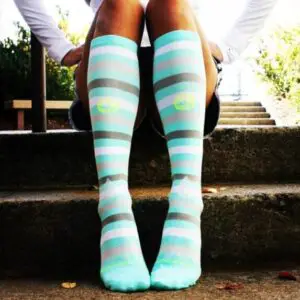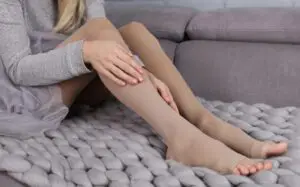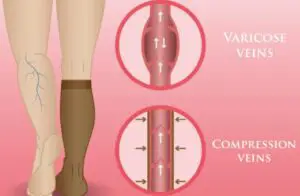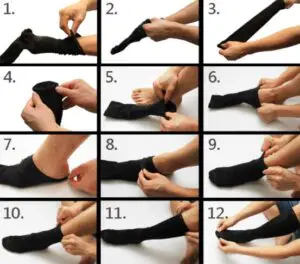Compression socks or stockings are suitable and recommendable for anyone to wear. They are not necessarily designed for patients since they assist in promoting general leg blood flow.
Compression socks work perfectly helping in equal blood circulation and parenting your legs from swelling. When making a compression sock purchasing choice, you need to be careful to ensure your choice gives you optimum benefit.
You are supposed to make sure you know or consult your doctor about the suitable compression level. Knowing a suitable size for your legs is very important for proper fitting. Using too small compression socks tend to cut your leg due to varying leg size to that of the garment. Different companies are providing compression socks at varying prices making them available in the market.
However, you need to concentrate on quality rather than price. For you to get the best or high-grade compression socks consider companies such as Medi, Juzo, and Sigvans. They have been in the market for decades.
In this article, we are going to tackle different topics about compression socks. We will get into details about basic things to put into consideration when deciding on compression socks. Types and importance of them to your legs’ health. And we will look at compression levels as well as things to avoid when wearing socks.
What Are They?
Compression socks are woven or knitted foot covering, made to take care of compression therapy.
They are aimed at promoting the effective flow of blood from your legs to your heart. This is made possible because compression socks are designed to apply tender pressure to your lower legs such as ankles. They reduce discomfort as well as leg swelling. They are perfectly designed, stretchy, and snug-fitting for squeezing slow legs.
Who Needs Compression Socks?
In recent years, huge numbers of people have engaged in the growing trend of wearing compression socks. Everyone is finding it comfortable to wear them whether as a medical recommendation or not. Here is a list of possible reasons for wearing or rather who needs them.

a) Pregnant women.
If they have or are at a high risk of varicose veins this prevents it from getting worse.
b) Athletes.
Most athletes are wearing compression socks before participating in the competition. They believe these socks prevent the occurrence of injuries during the event as well as enhancing their performance. Although there is no impact explained about this, there is no harm for wearing them.
c) After surgery.
People who recently gotten surgery or in need of bed rest, have high chances of developing leg blood clots that tend to be very dangerous. Doctors mostly prescribe compression socks to promote the flow of blood in the legs.
d) People with varicose veins, Diabetes, or deep vein Thrombosis.
Compression socks play an impact role in preventing serious complications to people with or at risk of named problems. To prevent deep vein thrombosis you are supposed to wear compression socks while spending long stretches traveling in a car or a plane.
e) For long-standing persons
Compression socks and stockings are suitable for people whose jobs require them to spend the day standing.
What Do They Do?
Compression socks and stockings help in applying gentle pressure to your ankles and legs. This is important in the following ways;
– Promoting the flow of blood to the heart from your legs.
– Preventing downward blood reflux to your feet or rather to your superior veins sidely.
– Increase blood flow velocity as well as its volume through major veins.
Importance of Compression Socks
Compression socks are designed to highly benefit your health as well as your well-being as a user. Here are some benefits of compression socks;

a. Muscle and joints support.
Compression socks play a key role in muscles as well as joints support. Whether you are active or suffering from joints and muscle problems, these socks assist you in walking and sitting. They put your muscles aligned in the right motion. Proper circulation of blood is elevated, fueling your joints.
b. Minimizes leg swelling.
Leg swelling may occur as a result of ankle injuries, recent surgery, and more. Compression socks will assist in reducing any chances of leg swelling. These socks perfectly carry away any fluid formed in affected areas of your limbs.
c. Reduces blood clots risks.
Compression socks prevent the pooling of blood in leg veins as they decrease the improper circulation of blood. This prevents the formation of clots within your veins.
d. Prevents venous disorders.
Your skin can change or swell when your leg vein valves are not properly functioning. Wearing compression socks reduces unwanted conditions such as leg inflammation that can cause varicose veins. To curb venous cancer affecting your legs you are supposed to wear the right compression socks for your legs.
e. Aids in feet recovery.
Since your feet bear all your body weight, wearing compression socks assist in repairing by bringing in blood rich in oxygen and nutrients. They also take away blood cells depleted of nutrients and oxygen. This makes your feet recover quickly to normal.
f. Limb protection.
Compression socks offer an additional protective layer for your legs. This prevents your legs from serious infections especially if you have diabetes. Your legs are also kept safe against cold climatic conditions as well as extreme ultraviolet rays.
g. They help in increasing stamina during exercise as your body doesn’t have lactate to obtain more energy.
This is because compression socks are perfect for enhancing oxygen circulation and providing the required energy for your measures.
h. Compression socks assist perfectly in enhancing lymphatic drainage.
Basic Things to Decide on Choosing Compression Socks
a. What do You Want Them For?
While choosing compression socks you are supposed to have the right reason for their need. This will help you to come up with the best socks for your health. You can need compression socks as a result of;
-
- Medical prescription.
- For athletic performance.
- Due to recent surgery or bed rest.
- Healthy conditions such as Varicose vein, diabetes, and deep vein thrombosis.
- For joints and muscle support.
- Improving blood circulation.
b. Compression Level
To find the right fit, you need to be sure about your compression level.
- 8 – 15 mmHg.
This is a lower or mild compression level. It relieves minor varicose veins.
- 15 – 20 mmHg.
This is a mild compression level. It helps in preventing varicose veins that are minor and moderate. It relieves aching legs as well as minor foot swelling.
- 20 – 30 mmHg.
This level of compression is moderate. It plays a critical role in preventing varicose veins that are moderate to severe. Also, relieves lymphatic edema.
- 30 – 40 mmHg.
This offers firm compression that prevents post thrombosis syndrome as well as management of ulcers.
- 40 – 50 mmHg.
Offers tighter compression that is good at preventing venous cancer.
c. Socks or Stockings
When you want to make a purchase order you are supposed to be specific about whether you need a stocking or socks. This decision will be determined by the reasons for purchase. Knowing what you want helps you in easing your decision-making process.
d. Suitable Materials
Compression socks are designed with a wide range of materials that you need to choose from. Some of the materials used for knitting these socks are; nylon, spandex, natural rubber, and cotton.
Since they are all produced at a varying thickness to achieve the required elasticity and appearance. You need to be keen when making your decision.
Types of Compression Socks
Socks and stockings are designed differently in terms of size, materials, and more. Socks vary in length as they are made to cover different body parts. You will find some that reach below your knee, while others get to the thighs.
Compression socks are supposed to make you feel comfy and not too tight to cause pain. Different kinds of compression socks are designed for varied reasons. Some compression socks types are;
a) Anti-embolism stocking.
They are also known as Thrombo-embolic deterrent hose. This kind of socks is mostly made for people who want to spend time in bed or bed rest as well as after surgery. They assist in preventing or reducing incidences of deep vein thrombosis. They are designed to provide inclined compression for people with low or no mobility.
b) Graduated compression stockings.
They are designed to fit people who can spend time standing and those who can move around. It offers gradient compression that is tight at the ankle and decreases as you move upward. Although they are meant to follow certain medical specifications they need a professional fitting.
c) Nonmedical support Hosiery.
Unlike Anti-embolism and graduated compression stockings, nonmedical support hosiery don’t require any prescription to wear. They assist in making tired and aching legs relieved. Although they are elastic they provide uniform compression with less pressure, unlike others. They are available online and at pharmacies.
How to Find the Right Fit?
To order or purchasing your compression socks is easier but achieving the right fit tends to be a problem for most people. However getting socks or stocking that perfectly fits you makes you feel comfy, and they will stay for a longer period. For you to get your perfect compression fit, make sure you do the following;
a) Measure the circumference of your leg calf.
You are supposed to have the right measurement of the widest point of your calf. This is the common base primary method of making the right purchase.
For example, if your calf size is between 13 to 16 inches, both genders can order compression socks size between 8 and 10.
For a calf size raging between 16 to 20 inches, a man can order socks size 11 to 13 while a woman can select 11 to 14 socks size.
b) Order your compression socks based on US shoe size.
In this case to archive the socks of tighter fit, you are supposed to select small socks. This is made possible because all sizes have similar calf widths of 20 to 24 inches.
Here, if your shoes are sized between 8 and 10, you are supposed to choose lower sized socks which could be small or medium.
c) Knee measurement.
To achieve a proper fit, make sure you have a measurement of your thigh about four inches on top of your knee cap.
For example, if you get measurements ranging between 16 to 18 inches, choose a medium-sized sock, smaller sized socks will give you a tighter fit while longer sized ones will offer a looser fit.
How to Wear Compression Socks Quickly? – Steps to Follow
You may be having your compression socks or stocking but you get into a dilemma on how to wear them or where to start. Here are few steps to follow;

a) Put your hand through into the socks and perfectly hold the sock’s heel.
b) Turn your socks inside out while grasping the heel. In that case, leave a pocket enough for your foot.
c) Into the foot pocket place your toes first and gently pull your socks up to the heel.
d) Hold the upper layer of the fabric at the foot middle and slowly lift it to your heel. Then pull it more upward to ensure the heel is perfectly covered.
e) With both hands grasp the fabric remaining and slowly pull over the calf.
f) Gently and carefully continue to pull and adjust it where necessary.
g) Make sure your garment fits perfectly. In case of any wrinkles, smooth them out. Then do the same for the other leg and you are done.
Things to Avoid on Wearing Them For Safety
Although doctors do recommend wearing compression socks to avoid or reduce a variety of health problems, you are supposed to wear them properly and with a lot of care. Wearing them has some dos and don’ts. Below is a list of things to avoid while having them.
-
Avoid wearing them at night unless prescribed by the doctor.
When sleeping your legs will be at a neutral position allowing smooth blood flow. Additionally, compression socks accelerate blood circulation. Since this is not necessary, you can use a pillow to position your legs rather than use graduated compression socks.
-
Don’t scrub or wring your compression socks to dry them since any excessive movement can destroy them.
For them to last longer and in good conditions always treat them gently. Squeezing them slowly after balling them can assist in getting rid of excessive water.
-
Avoid oily substances such as body lotions.
Any oily or lotions break down your compression sock’s elastic fibers. In case you want to apply oil to your legs you can do it after removing them later in the day.
-
Don’t use any bleaching substance such as chlorine, since it can destroy your compression socks.
Chlorine bleach contains harsh chemicals that react to your socks damaging them.
-
Avoid rolling or crumpling your compression socks.
Especially while putting them on and removing them because it creates bands that are tight enough to cut off blood circulation from legs to the heart.
-
Avoid altering your compression socks design.
Any change through cutting makes them uncomfortable to wear and can become ineffective. Whichever, kind of compression socks you are using refrain from alterations to attain the desired results.
FAQs
1. How do I Know What Compression to Buy?
To make the right decisions of compression socks to purchase you need to do the following,
– Measure your ankle circumference and use the result which could be around 7 to 10 inches.
– Measure your calf circumference and make an order using the results.
2. How Many Hours a Day Should You Wear Compression Stocking?
You are supposed to wear compression socks often. However, it depends on a few factors such as; in case you have been recommended to use them by a doctor, you will be given instructions on how to wear them. It could be all day, for some hours or extended periods. You can wear them every day but don’t sleep or lay down with them on.
3. Who Should Not Wear Compression Socks?
Although wearing compression socks helps in improving your general health and well-being, any person suffering from the peripheral vascular disease should not wear them. Wearing compression socks can make the disease affecting the lower extremities worse.
Conclusion
Unless you are suffering from a disease such as peripheral vascular disease wearing compression socks or stocking is good for your well-being. In case you have an issue of toe color change, as a result of wearing compression socks, consult a medical offer immediately. To achieve your desired results from compression socks refrain from any alteration to them.




